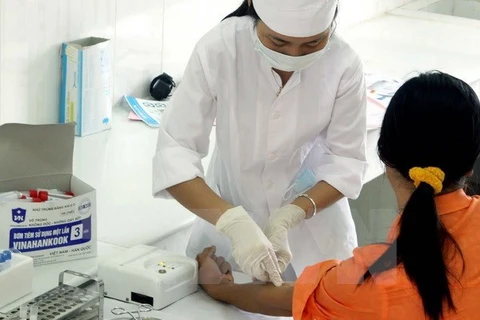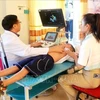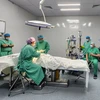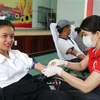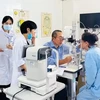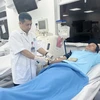 The HCM City University Medical Centre has reduced the waiting time from 90 to 60 minutes for testing results after putting in place an automated testing ward last Friday to improve quality. (Source: nld.com.vn)
The HCM City University Medical Centre has reduced the waiting time from 90 to 60 minutes for testing results after putting in place an automated testing ward last Friday to improve quality. (Source: nld.com.vn) HCM City (VNA) - The HCM City University Medical Centre has reduced the waiting time from 90 to 60 minutes for testing results after putting in place an automated testing ward to improve quality.
All testing samples of patients have a bar code and are sent to a modular pre-analytics system.
The testing results are now more and more exact, leading to higher effectiveness in treatment, while 30,000-35,000 tests are done at the centre every day.
The system is used in cooperation with the cobas 8000 analyzer series which meets laboratory workload and manages peak demand by delivering up to 9,800 tests per hour.
Moreover, the cobas infinity IT solutions help manage data and sample workflow and then automatically send them to the laboratory informatics system, directly connecting with the hospital informatics system.
Testing results are automatically sent to counselling rooms where doctors use them to assist diagnosis and treatment.
Patients also can receive the results via email or phone messages.
Dr Nguyen Thi Bang Suong, head of the ward, said the automated testing systems would help minimize errors. They also would help raise satisfaction among patients and the reputation of the centre, she added.
Speaking at a recent conference on testing quality held in HCM City, Deputy Head of the city's Department of Health Tang Chi Thuong has instructed hospitals to closely monitor the quality of tests.
"This is one of the activities which hospitals should give priority to their annual plan," Thuong said.
He said that reducing the waiting time for test results was one of the indexes showing the quality of the testing ward.
"IT application in testing such as bar codes for testing samples are used to avoid mistakes," he said, adding that the application should be used in transportation between clinical wards and labs, instead of nurses who bring them to the sites.
They should also periodically update the list of devices and equipment which ensure provision of test services that meet the hospital's treatment protocol, he said.
Dr Luong Ngoc Khue, head of the central government's Department of Medical Examination and Treatment, said the yearly average increase of tests at hospitals had been 10 percent since 2011.
As of May, only 46 testing labs at nearly 1,400 public and private health facilities throughout the country have met ISO 15189 standards, he said.
Hospitals in provinces such as Nam Dinh, Ninh Binh, Long An and An Giang have increased testing services, thanks to more investment in equipment and devices, according to Khue.
They have reduced the rate of transfers of patients to higher- level hospitals from 22.3 percent to 7.6 percent because of a shortage of testing devices and equipment used in diagnosis and treatment.-VNA


